Scientific discovery aboard the HMS Endeavour
Bill Dennison ·An exact replica of the HMS Endeavour arrived in Brisbane, Australia for a visit of several weeks. The 100 foot three-masted ship was built in Freemantle, Western Australia between 1988 and 1992, and has sailed twice around the world. It is operated by the Australian National Maritime Museum and is based in Sydney Harbour. The replica was faithfully modeled after the original and includes a piece of ballast recovered from the Endeavour River in North Queensland that all visitors are expected to kick for good luck. The tiny and cramped quarters that the 94 men shared aboard the ship could be appreciated when stooping or even crawling below decks.
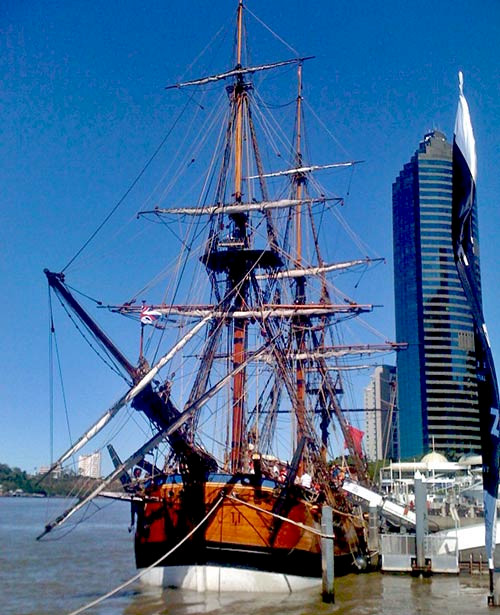
When I was a postdoctoral researcher at the Marine Sciences Research Center, Stony Brook University, we named four buildings; Endeavour, Discovery, Challenger and Dana after famous ships of discovery. We had a special seminar about the ships, and Dr. Malcolm Bowman, a native New Zealander, talked about the Endeavour, Dr. Ed Carpenter talked about the Challenger, Dr. Glenn Lopez talked about the Dana and I talked about the Discovery. I recall Malcolm showing us a New Zealand dollar with the Endeavour engraving depicted. We had a chuckle, when one of the faculty overheard an administrative assistant on the main campus say "Isn't nice that the Marine Sciences people named their buildings after the Space Shuttles?" It turns out that the Space Shuttle Endeavour is now at the launching pad awaiting its final space flight and on its maiden voyage in 1992, it carried aboard a small wooden peg called a 'trunnel' that was the last nail hammered into the replica ship as it was built.
Observing the transit of Venus in Tahiti
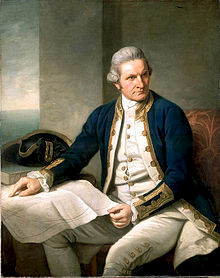
Captain James Cook sailed the original HMS Endeavour from Plymouth, England to Tahiti to observe the transit of Venus across the moon. The reason for this journey was to observe the exact time that it took Venus to cross in front of the sun from widely spaced locations across the globe. The astronomical question was to establish the size of the solar system, and determining the distance from earth to Venus would be an important step in calculating the distances to the other planets. Venus only passes in front of the sun twice, separated by eight years, but the next pair of transits were separated by 120 years. The astronomer Edmund Halley (of Halley's comet fame) surmised that by measuring the transit time at different points on the globe, the parallax that occurs from observing the same thing from slightly different angles would result in slightly different results, and trigonometry can be used to determine the distance between objects. Halley realized this in 1716, but the next transits of Venus were not until 1761 and 1769. Weather obscured the attempts to observe the 1761 transit. So for the 3 June 1769 transit of Venus, the HMS Endeavour would transport an astronomer, Charles Green, to recently discovered Tahiti to observe the transit. Captain James Cook was selected to command this journey and he took a scientific team, headed by Joseph Banks with him.
James Cook and Joseph Banks
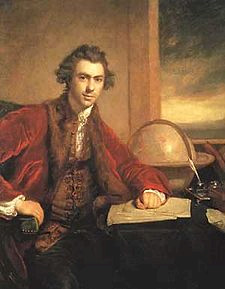
James Cook was a superb mariner and was 39 years old when he set sail in 1768. Joseph Banks was 26 and he brought with him two botanists, Drs. Daniel Solander and Herman Sporing, Jr. and an artist, Sydney Parkinson. Solander was a Swede, trained by Carl Linneaus, the Swedish biologist who invented the Latin naming system still used today. Sporing was a Finnish botanist. Cook graciously shared the great cabin at the stern of the Endeavour with Banks and his team so that they could examine and catalog their many specimens.
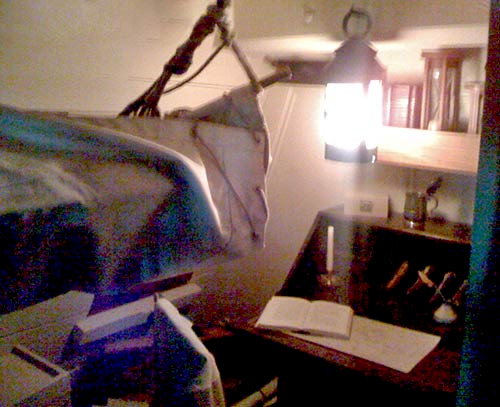
Following their long visit to Tahiti and their measurements of the transit of Venus, Cook sailed to New Zealand where he spent almost six months charting the coast. He then sailed west in search of 'Terra Australis', the proposed southern continent, and landed on the east coast of Australia (which he named New South Wales) just south of what is now Sydney. This location, Botany Bay, was named for the plethora of new plants that Banks and his botanists were discovering. They then sailed north, naming Morton Bay (later misspelled permanently Moreton Bay), and many other features of the east Australia coast. The journals of Captain Cook and Joseph Banks are good reading and there are several observations described by either or both men that are particularly compelling on their voyage along the Australian coast.
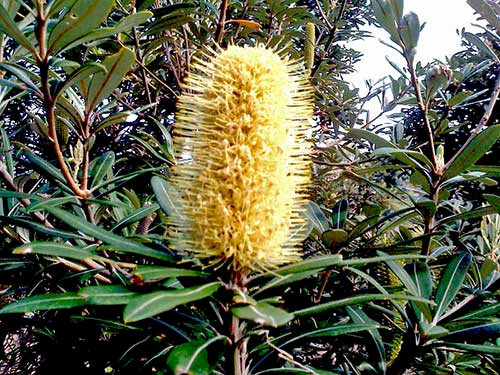
Cook observes evidence of flooding
An observation that is particularly relevant during the 2011, a year of Queensland flooding, was made by Captain Cook on May 30, 1770. Cook landed between Shoalwater Bay and Broad Sound on the central Queensland coast and made the following observation: ". . . I believe in the rainy Seasons here are large land floods, as we saw in many places Gullies, which seem'd to have been made by torrents of Water coming from the Adjacent hills, besides other visible signs of the Water having been a Considerable height above the Common Spring Tides. Dr. Solander and I was upon a rising Ground up the inlet, which we thought had at one time or another been overflow'd by the Sea, and if so great part of the Country must at that time been laid under Water." Banks made a similar observation, "It seemed to be subject to a severe rainy season, so at least we judgd by the deep gullys which we saw had been plainly washd down from the hills of a small hight."
This is the first of three posts about the voyage of the Endeavour
The other two posts are:
2. The HMS Endeavour ‘discovers’ the Great Barrier Reef
3. HMB Endeavour sets sail
About the author
Bill Dennison

Dr. Bill Dennison is a Professor of Marine Science and Vice President for Science Application at the University of Maryland Center for Environmental Science.
Next Post > Stoplight colors for environmental report cards
Comments
-
Nicolson 8 years ago
Great article Dr. Bill, had to research with any details related to HMS Endeavour and I am glad you have an article saying something with HMS Endeavour. It helps me a lot, I also need to find online about the details different flowers in Australia. I need to find resources for this. Maybe you know some website I can dig into? Thanks

